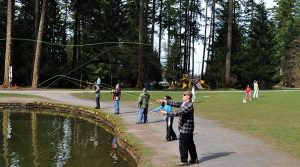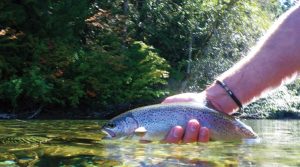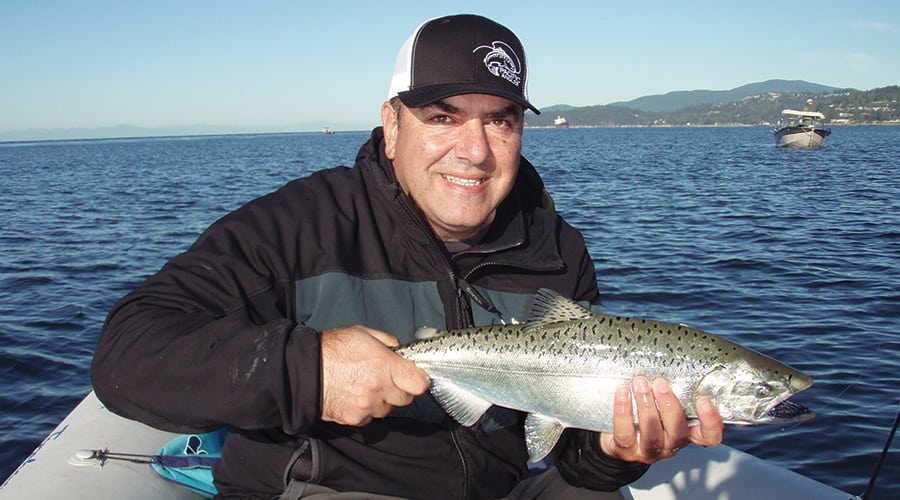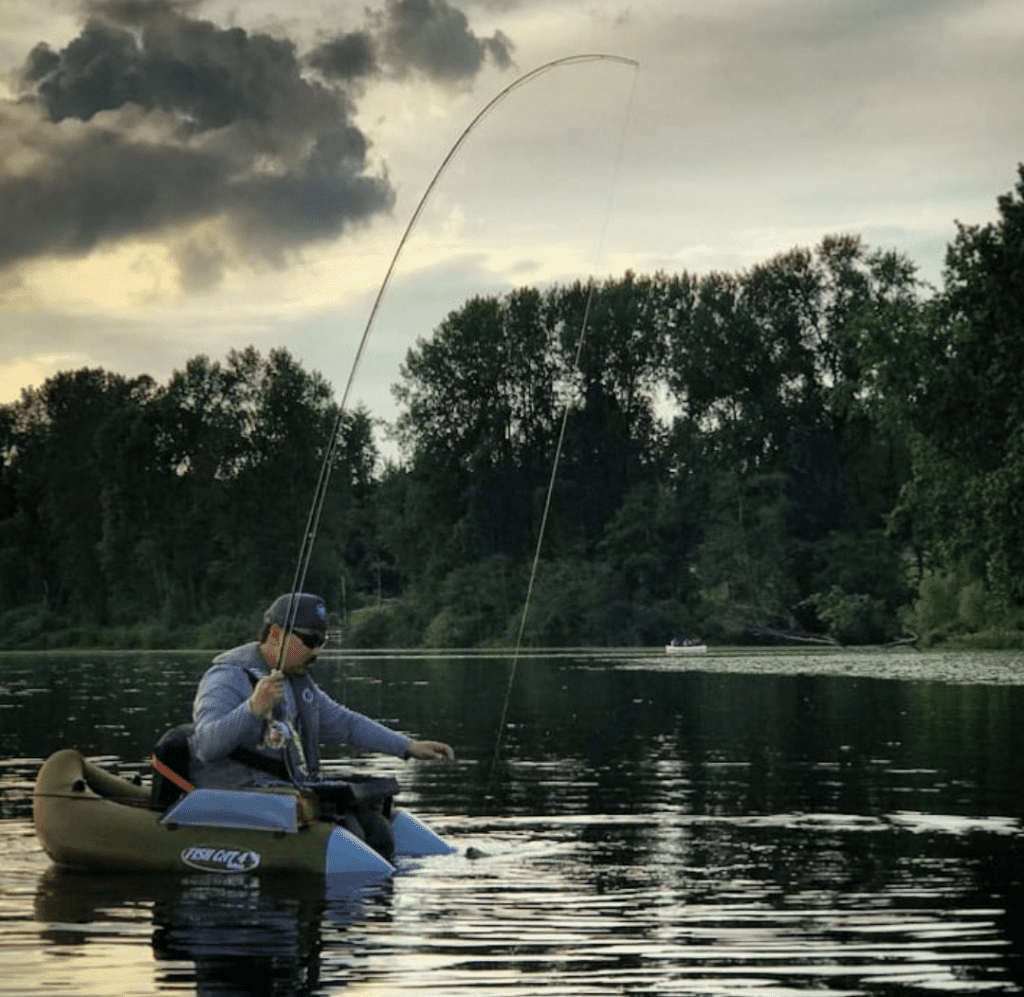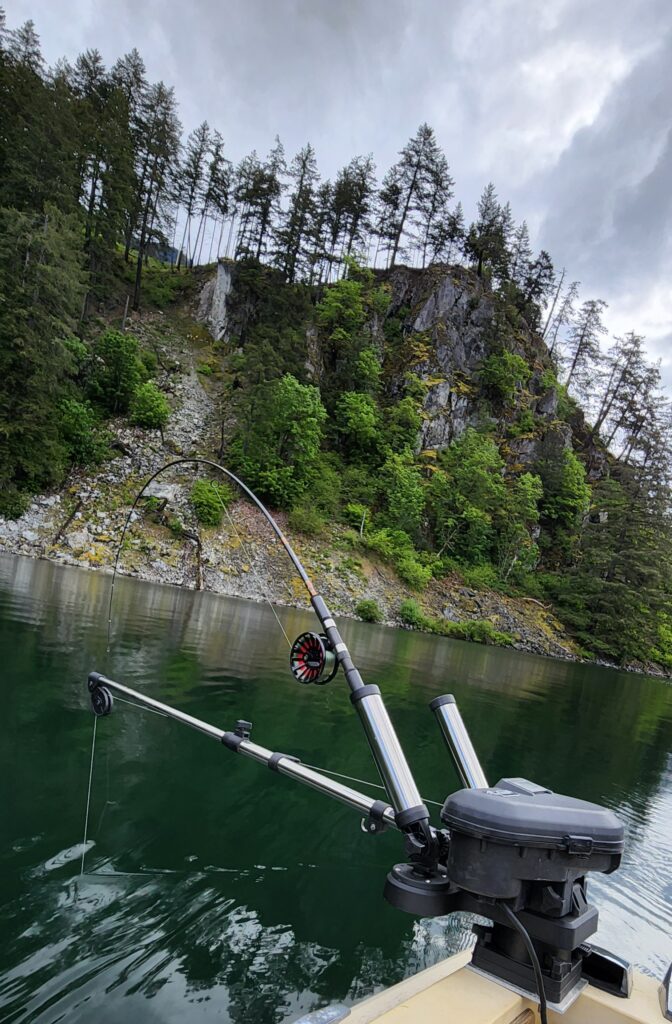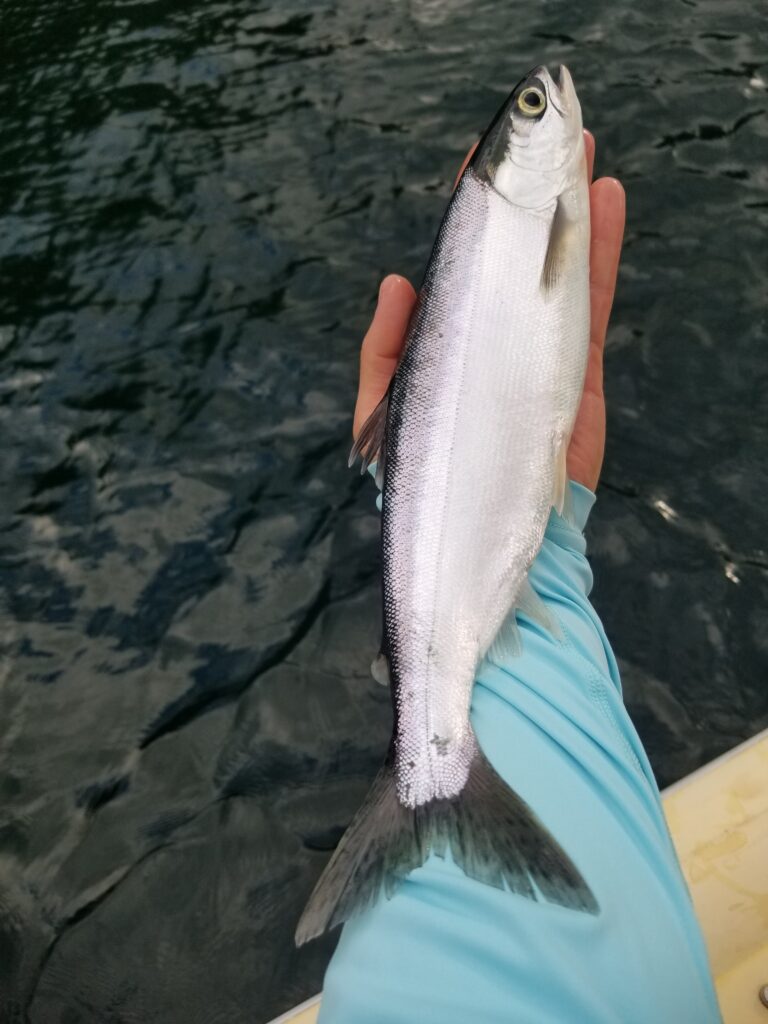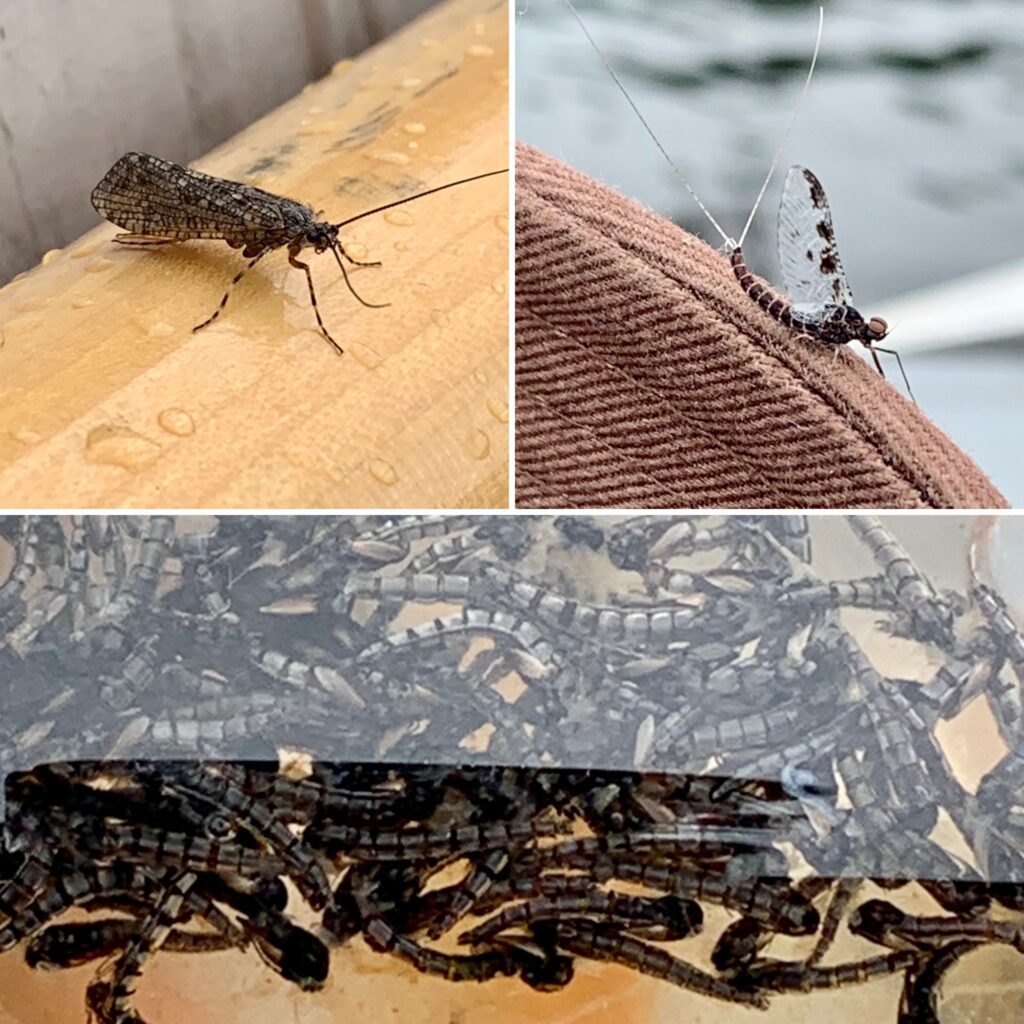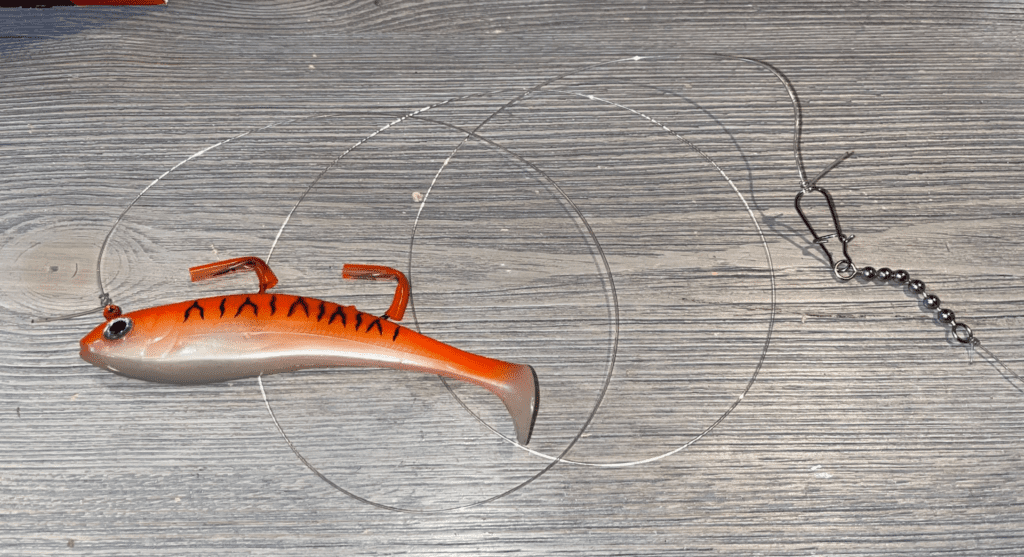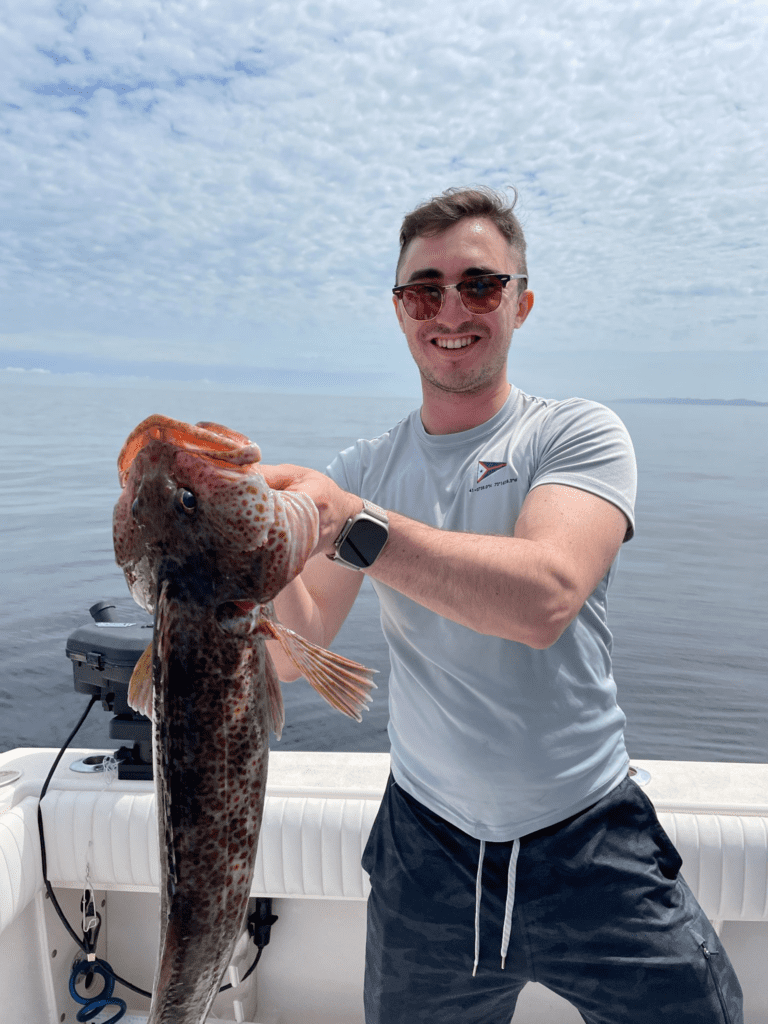OUTLOOK
We have a mixed bag of weather coming this weekend, but with seasonal temperatures, some sun, and clouds, it should be a good weekend to get out fishing.
This week, we have three interesting articles. The first is an article on how easy it is to get into the lake fishing game, even if you can’t get access to a hard-bottom boat. Float tubes are sometimes forgotten about, but they are so versatile if you are limited on access, storage, or budget.
The second article carries on with Taylor’s big lake fishing article from last week, where he looked at how to target bull trout and rainbows in our larger, less productive lakes. This week, he has tips and techniques for how to target kokanee in these same larger lakes.
For the saltwater angler, Josh tunes in with an article on bottom fishing. He has been guiding across the strait this month and wants to share how we troll paddle tails to cover more water and consistently get lingcod and rockfish.
Last but not least, Jason has an Interior Lake fishing report. He just came back from a trip and will share what he saw in terms of bugs and tactics, not to mention some pictures of huge rainbows.
CLASSES AND COURSES
Introduction to Fly Fishing
This course is specifically designed to give the new fly fisher the basic knowledge, casting skills and fly fishing strategies to effectively fish our local BC waters. This course is comprised of two sessions; 3hr evening seminar and a 3hr casting session. The dates below show the seminar date first and casting date second.
Dates: Jun 14 & 17, July 11 & 15, Sept 19 & 23
Cost: $175.00+GST
Seminar Time: 6:30pm – 9:30pm
Casting Time(s): 10am – 1pm or 1:30pm -4:30pm
Fly Fishing Trout Streams
Stalking trout on mountain streams defines fly fishing. In this course we will teach you the fundamental techniques for fly fishing trout streams; dry fly fishing, nymphing, and streamer fishing.
This Introduction to Fly Fishing Trout Streams course will get you as close to being Brad Pitt (A River Runs Through It) as you will ever be! This course is comprised of one 3hr evening seminar.
Date: June 20, 2023
Cost: $60.00+GST
Time: 6:30pm – 9:30pm
Fly Fishing On Beaches Course
This single evening 3hr seminar will cover the basic principles needed to be an effective beach fly fishermen in BC from Howe Sound to the east coast of Vancouver Island. Topics covered will include rods, reels, fly lines, flies, tides, and techniques. Andre Stepanian, the instructor for this course, has been chasing salmon on our local beaches for over two decades. 2023 is a pink salmon year in the Lower Mainland and remember, east coast Vancouver Island has a pink salmon run every year.
Date: Wednesday June 21, 2023
Cost: $60+GST
Time: 6:30PM
STILLWATER FISHING REPORTS
Local Lake Fishing Unlocked with Small Watercraft
Some of the best fishing in Lower Mainland lakes can be unlocked with a small watercraft. Small inflatables have been a fixture in the fishing world as early as the 70’s and 80’s. Float tubes, pontoons, pack rafts, and even SUP Boards have made it much easier for the weekend warrior to get out and connect with more fish. As the days get longer and the lakes warm, we see less opportunity to productively fish from the shore. It’s a great time to pull out the hand pump and explore the deeper structure, shoals, and drop offs with a small inflatable boat. Gear and fly anglers will benefit from the extra mobility. Try trolling flies or gear slowly along drop offs or anchor off points with structure to fish them directly. We have some tips and tricks to have the most of your time on the lake.
Pack Light. Space can be a premium on a small inflatable so only pack the essentials. I like to organize my gear in small tackle trays and fly boxes to stash in the gear pockets. Have your rods rigged and ready to go on shore before heading out. Try to stick to one rod at first. Packing or fishing multiple rods can be challenging when first starting out. Bonus points if you pack plenty of snacks, water, and sunscreen. Have a dry safe place for your keys, wallet and phone.
Waders are commonly used with float tubes and pontoon boats. Any good chest wader will work but I prefer lightweight breathable waders in the summer. I pair these with a lightweight Vibram sole boot. If you are only fishing from the float tube have a look at the flyweight series of boots from Simms. These are light and nimble making a day of flipper work easier.
Small inflatables can be endlessly customized. You can add rod holders, fish finders, and even electric motors making them very capable on almost any water. We have plenty of scotty products to trick out your rig. Motors and electronics will need power so look for Lithium batteries to save on weight.
Lastly, I will note a few tips for the SUP anglers out there. Paddle boards have popped up everywhere and it was only a matter of time before people started fishing off them. I have taken my board to many local lakes for trout, bass, and even carp.
- Use a dry bag to lash your gear to the deck or carry as a backpack.
- Have a leash on your paddle. This will keep your paddle at hand when fishing.
- Wide boards are better suited to fishing.
- Start on a calm lake. Waves and wind can make fishing almost impossible.
– Throw a floating retention strap on your sunglasses


A great selection of Fish Cats and accessories in shop!
Not everyone has the space or funds to own a boat. Inflatables can easily be packed up and put into a small car, closet or storage unit. Some of the lighter models are suited to back packing, giving athletic anglers a shot at some truly remote fishing opportunities. If you want big adventure from a small boat, come into shop and we can get you set up!
Cheers,
Eric
Big Lakes Tactics Vol #2 Kokanee Trolling
As I briefly mentioned in my previous report, there are a few local lakes that support good-to-decent kokanee fisheries, in addition to the big bulls and ‘bows that I talked about last week.
Kokanee are simply a landlocked form of sockeye salmon, with their physical and behavioral characteristics being quite similar. Kawkawa Lake and Alouette Lake are the two main local fisheries, though kokanee can be encountered in a few other lakes as well. Alouette is a relatively large, deep reservoir that is known for producing fairly high numbers of kokanee, though at a fairly small average size; Kawkawa is a small pothole-type lake in Hope that produces good numbers of slightly larger fish. The main downside to Kawkawa is the fact that it is a very popular lake for water-skiers, wakeboarders, and other “recreators”, so it can get alarmingly busy on a warm day. Being a small lake with no speed limits, it is inadvisable to be out there in a small boat when the “recreators” start getting out on the water in force… unless you like being waked out incessantly.
As mentioned, kokanee can be found in some other local lakes, though there is a bit of a debate here- some of these other lakes support populations of sockeye salmon, and there is some concern that the “Kokanee” that people are catching are actually juvenile sockeyes that are spending an extra year or two in the lake; this theory is supported by the rather small size of the “Kokanee” in question. As such, I’m not going to talk about these other fisheries in this report.
Kokanee are a schooling fish, so it’s no surprise that trolling is the most common method for catching them, since you can cover a bunch of water to increase your odds of coming across a school. Downriggers are a very helpful piece of kit, as is a fishfinder- the reason for this is that kokanee will usually form dense schools at a specific depth, and they don’t usually like to move up or down to intercept a lure. The fishfinder will tell you what depth the fish are at, and the downriggers will allow you to put your gear at that exact depth.
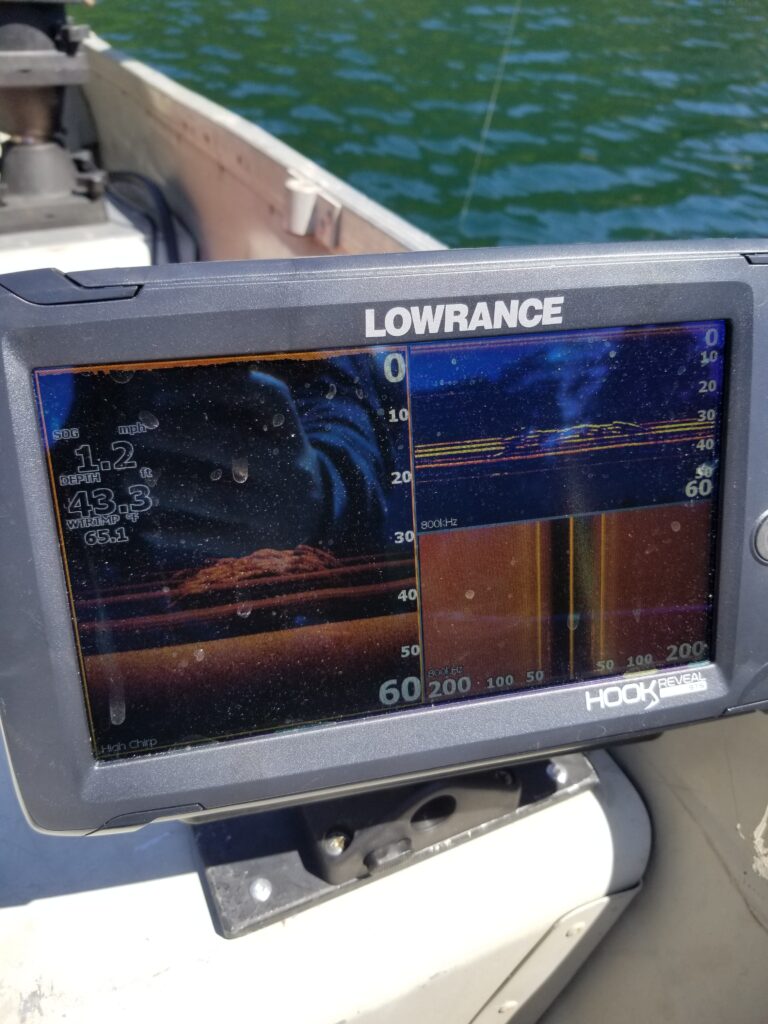
If you don’t have downriggers, you can still troll with something like a Deep Six diver or leadline, though you lose a lot of depth control and may notice some lackluster or inconsistent results. This becomes especially apparent as the water temperatures start to rise, the lake starts to stratify and the kokanee start to aggressively seek out the thermocline.
Several manufacturers have started producing rods that are specifically designed to troll for kokanee, all of which will feature a slow action, parabolic bend, and enough backbone to reliably pop downrigger clips. Since kokanee are known for having soft mouths that are prone to damage if fought too aggressively, these “softer” rods make pulling hooks out of fish a bit less likely. I personally run the Okuma Kokanee Black, though any soft, light-action rod in the 6’-8’ range will work fine. If you don’t have a soft, slow-action rod at your disposal, you can still get away with using a stiffer rod, just be sure to use a trolling snubber to avoid ripping the fish’s faces off. Levelwind reels are preferred, since spinning reels are notorious for twisting line when trolling, though I have run spinning reels in the past with minimal issues. I personally use a heavy-duty 7/8wt. fly reel that I have spooled with 12lb mono and a lot of backing, since it acts a lot like a small mooching reel.
Kokanee trolling gear will often mimic the gear that you would use when trolling for sockeye in saltwater, though on a significantly smaller scale. Kokanee are easily attracted by flashy gear, much like their anadromous cousins, so a good dodger or gang troll is an invaluable, almost necessary piece of kit; my usual go-to is the Gibbs Dogtail. Some savvy kokanee anglers will even run dummy dodgers off their downrigger lines, so that is something to consider as well. Small hoochies, wedding bands, and spoons will all produce well, and a bit of scent never hurts either. There are a lot of interesting lures on the market that are designed specifically for kokanee, so it can be fun to cycle through a bunch of novel lures to see which ones work best; I have found some of the odd creations from Mack’s Tackle to be quite effective. I usually troll quite slowly, almost never exceeding 1.6mph, though I know a lot of successful anglers that find a lot of success on a faster troll. Once you have your gear set up, it’s pretty straightforward- keep an eye on your fishfinder while you’re trolling around, and when you see a school of fish, set your gear to that depth. As a general rule, when you find one school, it’s pretty safe to assume that all of the other fish will be around the same depth. If you troll through a few schools and don’t get a hookup, consider changing your lure, dodger, or trolling speed. Continue changing it up until you find something that consistently produces.
If trolling isn’t your thing, you can anchor up and fish bait or jig lures under the boat- this is quite popular and can be quite productive on some of the smaller kokanee lakes, such as Kawkawa. Note that this style of fishing isn’t as consistently effective on larger lakes, since the fish will be spread out over a larger area. Corn, krill, shrimp, or salmon eggs all work well, as do small jigs or spoons. This type of fishing can usually be described as “off” or “on”. If there is a school of fish under you, you’ll usually be catching ’em as quickly as you can get your bait down there, but if there isn’t a school below you… well, I hope you don’t bore easily, because you’re going to be catching a whole lot of nothing until the next school of fish happens to swim under your boat.
Kokanee are a tasty fish that average 11”-14″ in the Lower Mainland, but they are notoriously fragile and do NOT handle catch and release very well, with mortality rates often exceeding 50%… even when they are handled properly. As such, I strongly recommend only fishing until you have retained your limit- there’s no real point in practicing catch and release if most of the fish you release die anyways. When retaining a fish, be sure to bleed it promptly and get them on ice as soon as possible, as kokanee tend to spoil very quickly, especially in the hot summer months. I find mornings to be the best times to fish for kokes for a few reasons… temperatures are more bearable in the summertime, the fish are usually a bit more “bitey”, and the water-skiers, wake-boarders, and other “recreators” are usually still in bed, sleeping off their hangovers from the previous night.
Fishing for kokanee is one of my favorite Spring/Summertime activities. It’s a lot of fun… almost like a scaled-down version of trolling for salmon in the salt, and you get to take home some great eating fish. Be sure to check regulations on your specific lake before you head out and be mindful of the fact that a lot of our kokanee lakes also have populations of other fish that may or may not be open for retention, so be sure to properly I.D. your catch before you bring it into the boat.
Taylor Nakatani
Interior Lakes Fishing Report
It’s the last week of May and we are well on our way into the lake fishing season. The last 2 weeks of May are always a good bet and some of the most anticipated of the year. From the reports we are getting it sounds like fishing has been good on most of the lakes. After the heatwave it is good to see temperatures in the Kamloops and Cariboo region backing off. For the most part it looks like we are in for mid-twenties during the daytime and high single digits to low teens in the evening. This is great news, as some lakes were getting surface temps as high as 73F but with the rain we had and cooler weather, they are back into the 60s or lower on some of the very high elevation lakes.
The food source for the trout this time of year is highly variable. Each lake is different and some lakes are known for their chironomid hatches while others are known as good mayfly or caddisfly (sedge) lakes. Elevation always plays a major role. I was on a higher elevation lake this week and it was 6C outside, raining and the day started off with blobs. It felt more like early season than late May. Earlier in the week on lower elevation lakes it was shorts and t-shirts, and the mayflies were coming off.
In short, be prepared for it all. Make sure you have your attractor patterns like blobs and boobies, staple food sources like scuds and leeches, and be prepared for all the major hatches; chironomids, mays, damsels, caddis, and dragons. You never know what is going to be the hot fly and presentation this time of year. Your best bet is to land that valuable first fish and take a throat sample, which is a critical tool in figuring out the puzzle. Short of that, keep an eye out for activity on the surface of the lake. Are there lots of dragonfly, mayfly, or damselflies around? Are there chironomids hatching or evidence or a previous hatch. Take a look around the boat launch and the surrounding vegetation for clues into what has been happening for insect activity.
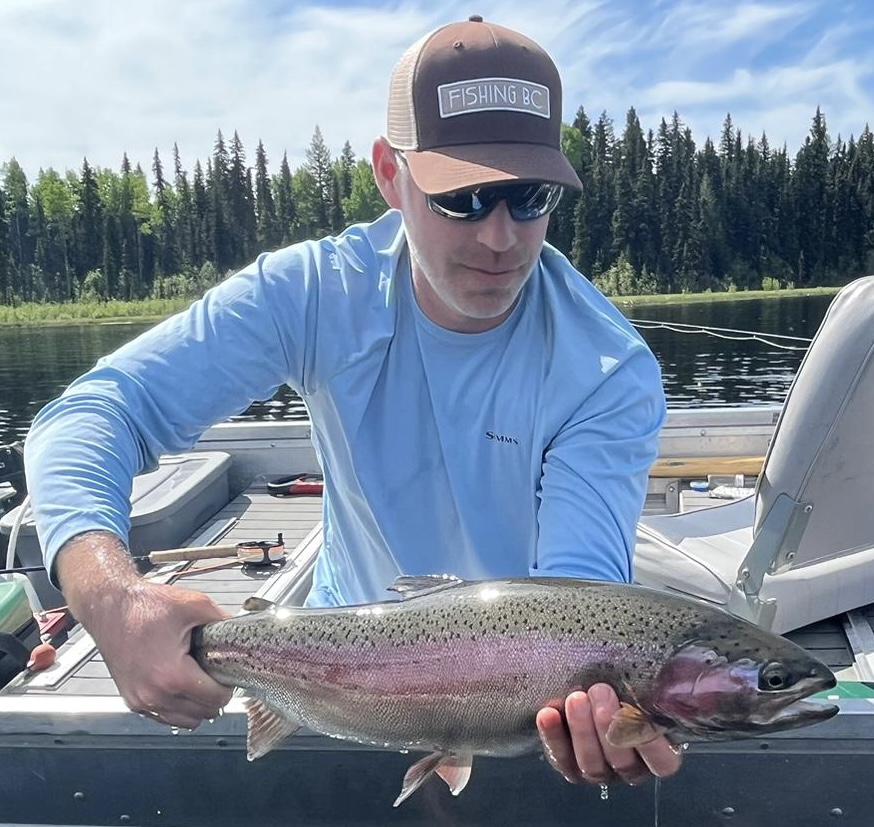
I also like to take my time before setting up, slowly rowing around the lake, looking for feeding fish, rolling fish, and fish on my sonar. I generally won’t anchor until I see something compelling. If you are in a spot for 30-45 minutes and you aren’t seeing signs of fish on your sonar or the surface, time to move. Keep moving and observing until you find fish or catch a fish. Compile all the information you can, fish activity, hatches, water temperature, and your success (or sometimes lack of) into a journal and you will start to figure things out. If you are heading to the same lake in future seasons, you will find this information invaluable.
See you in the shop or on the water,
Jason Tonelli
SALTWATER FISHING REPORTS
How to Troll For Bottom Fish
Trolling paddle tail swimbaits in conjunction with downriggers can be a great way to cover water when bottom fishing! This is a simple yet effective way to target bottom fish that uses the same salmon fishing gear you might already have.
First of all, tie on a bead chain and duo lock to the end of your mainline, follow up with a 3–4-foot length of 60lb mono, then tie on your paddle tail. Personal favorites are Gibbs Power-paddles, or Lighthouse Lures Max Shads. Clip your paddle tail to your Power Grip clip and send it down near the bottom.
For instance, when trolling in 150 ft of water, drop your swimbaits to 150 ft. Since you are trolling, the blowback from current or your movement will raise your actual depth so you’re not hanging up on bottom. Blowback is the angle of the downrigger cable in conjunction with your boat speed. For example, if the downriggers are set to 150 ft, but you’re trolling at two or three knots, your actual fishing depth is closer to 120 ft. Generally speaking, with lingcod and rockfish, you want to be trolling 10-20 feet off bottom, around one to two knots, or have a cable angle of around 10-20 degrees.
On a side note, depending on which way the current is moving will change which way you position yourself in relation to the structure. You want to go with the current, not against it. Lingcod and rockfish are extremely structure dependent, focusing your efforts on pinnacles and ledges will greatly improve your chances.
This method of fishing is extremely simple, but you need to pay extremely close attention to your depth sounder and downrigger depths or you might lose your cannon ball. If you see the bottom start to come up on the sounder, adjust the depth on your downriggers accordingly.
Good luck out there and have fun!
Josh Lo


